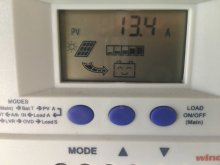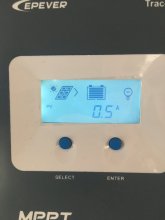Joined the forum after browsing for a while gathering information and now, I have an issue that I can’t figure out. Recently purchased two Epever Tracer 4210AN with the hopes of running them in parallel. I have two 4 panel arrays, one using Rich Solar 100-watt panels in parallel and the other using Reneogy 100-watt panels also in parallel. The plan was to have each 4210AN controlling a 400-watt array feeding my battery bank, two Reneogy AGM 12v 200ah batteries (AGM12-200) in parallel, a 12-volt system.
My problem started the day I got the Epever’s. It was very sunny, no clouds in the sky and the temp around 95 so I decided to test the controllers to make sure they both worked. After replacing my current controller with a 4210AN all was well. Had six panels making over 20amps and then nothing, zero amps but voltage was still reading. Checked all my connections and everything was good but no amps. After a few minutes the amps slowly started to rise and then jumped to 25 and everything was good again until…zero amps. This cycle happened over and over and wasn’t due to clouds, there were none. So, I figure the controller is bad, swap it out for the other new 4210AN and same thing happens. There was no load from the controller load connections but I was pulling about 400 watts from my inverter running lights, fans and a TV. This happened for two days and I couldn’t figure out why, read the manual multiple times, checked the temperature of the controller and the batteries, both well within limits. I contacted the company I bought the controllers from through Amazon and they asked for screen shots from the display. I figured I’d do one better and spent the next two days trying to get the Epever monitoring software running for accurate information, this was a task by itself and if you want to know that story just ask.
So the attached information is data from Epevers software during what I’ll call “A Dropout”. It was a little overcast on the day, was using four panels in parallel for a possible 400 watts. The jpeg with the four screenshots is “A Dropout” as it happens: Number 1 is the system running fine, making power. Number 2 the drop out has occurred, zero amps from the array but 19.9v, and the solar status block says “cut out”. Number 3 is charging starting to occur again, solar status is “input” but the SOC is down to 46%. Number 4 is back to what appears to be normal operations and the SOC has jumped to 100%, all of this happens in a span of 3 to 5 minutes, was pulling around 350 watts from my inverter during this running fans and a TV. I sent all this information to the company I purchased from and was told:
“There is no problem with the controller. The input power of your solar panel is too low, so the current converted to the battery will not be very high.
PV voltage * PV current = Battery voltage * Battery current
Epever-readings-2.jpg
1. 17.03*13.63 =13.57*17.05 (almost equal)
2. Is the battery charging voltage you set 17V? You see if the parameters of your battery can be set 17V. The controller defaults to 14.4V.
3.19.9*0.08=12.51*0.15
4.17.15*13.06=13.52*16.6
The actual input power of your solar panel to the controller is only 230W, which is too low.
Low sunlight intensity? Or is the installation angle of the solar panel wrong? It is recommended that you increase the power of the solar panel.
And you can consider two solar panels in series, and then two groups in parallel. Increase the input voltage.”
I’m still new at this and understand the likeliness of getting two bad controllers at the same time is slim but their answer doesn’t seem right. I’d appreciate anyone offering input. Thanks
My problem started the day I got the Epever’s. It was very sunny, no clouds in the sky and the temp around 95 so I decided to test the controllers to make sure they both worked. After replacing my current controller with a 4210AN all was well. Had six panels making over 20amps and then nothing, zero amps but voltage was still reading. Checked all my connections and everything was good but no amps. After a few minutes the amps slowly started to rise and then jumped to 25 and everything was good again until…zero amps. This cycle happened over and over and wasn’t due to clouds, there were none. So, I figure the controller is bad, swap it out for the other new 4210AN and same thing happens. There was no load from the controller load connections but I was pulling about 400 watts from my inverter running lights, fans and a TV. This happened for two days and I couldn’t figure out why, read the manual multiple times, checked the temperature of the controller and the batteries, both well within limits. I contacted the company I bought the controllers from through Amazon and they asked for screen shots from the display. I figured I’d do one better and spent the next two days trying to get the Epever monitoring software running for accurate information, this was a task by itself and if you want to know that story just ask.
So the attached information is data from Epevers software during what I’ll call “A Dropout”. It was a little overcast on the day, was using four panels in parallel for a possible 400 watts. The jpeg with the four screenshots is “A Dropout” as it happens: Number 1 is the system running fine, making power. Number 2 the drop out has occurred, zero amps from the array but 19.9v, and the solar status block says “cut out”. Number 3 is charging starting to occur again, solar status is “input” but the SOC is down to 46%. Number 4 is back to what appears to be normal operations and the SOC has jumped to 100%, all of this happens in a span of 3 to 5 minutes, was pulling around 350 watts from my inverter during this running fans and a TV. I sent all this information to the company I purchased from and was told:
“There is no problem with the controller. The input power of your solar panel is too low, so the current converted to the battery will not be very high.
PV voltage * PV current = Battery voltage * Battery current
Epever-readings-2.jpg
1. 17.03*13.63 =13.57*17.05 (almost equal)
2. Is the battery charging voltage you set 17V? You see if the parameters of your battery can be set 17V. The controller defaults to 14.4V.
3.19.9*0.08=12.51*0.15
4.17.15*13.06=13.52*16.6
The actual input power of your solar panel to the controller is only 230W, which is too low.
Low sunlight intensity? Or is the installation angle of the solar panel wrong? It is recommended that you increase the power of the solar panel.
And you can consider two solar panels in series, and then two groups in parallel. Increase the input voltage.”
I’m still new at this and understand the likeliness of getting two bad controllers at the same time is slim but their answer doesn’t seem right. I’d appreciate anyone offering input. Thanks








